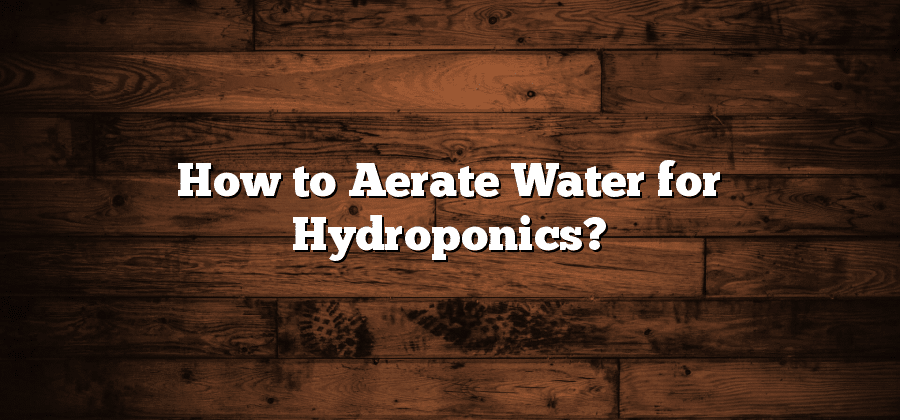Understanding the Importance of Water Aeration in Hydroponics
Water aeration is a critical aspect of hydroponics that should never be overlooked. This process involves introducing oxygen to the water, creating an ideal environment for plant roots to thrive. Adequate oxygen levels are essential for the overall health and growth of plants in hydroponic systems. Without proper aeration, roots may become waterlogged and suffocate, leading to stunted growth or even crop failure.
The main purpose of water aeration in hydroponics is to ensure that roots receive sufficient oxygen. In conventional soil-based gardening, roots naturally absorb oxygen from the surrounding soil. However, in hydroponics, where plants are grown in water or a soilless medium, it is necessary to provide oxygen artificially. Aeration systems help to achieve this by promoting the exchange of gases in the water, allowing plants to access the necessary oxygen for respiration. This oxygenation process also helps to prevent the growth of harmful bacteria and pathogens, promoting a healthier and more disease-resistant environment for the plants.
Factors Affecting Water Aeration in Hydroponic Systems
Factors Affecting Water Aeration in Hydroponic Systems
When it comes to hydroponic systems, water aeration plays a crucial role in ensuring the overall health and productivity of plants. Effective aeration promotes the circulation and availability of oxygen throughout the water, facilitating nutrient absorption and root development. Several factors can affect the level of water aeration in hydroponic systems, ultimately influencing the success of your crops.
One factor to consider is the size and type of your hydroponic system. Larger systems tend to require more aeration due to the increased volume of water. Additionally, different types of hydroponic systems, such as deep water culture or nutrient film technique, may vary in their aeration needs. It is important to understand the specific requirements of your chosen system to ensure optimal oxygen levels. Another critical factor is the water temperature. Warmer water tends to hold less dissolved oxygen, making aeration even more vital to maintaining adequate oxygen levels for plant growth. Monitoring and adjusting the water temperature in your hydroponic system can help optimize aeration efficiency.
Selecting the Right Aeration Method for Hydroponics
When it comes to selecting the right aeration method for hydroponics, there are several factors to consider. One of the most important factors is the size and type of your hydroponic system. Different systems may require different types of aeration methods to ensure optimal oxygenation for plant roots.
Another factor to consider is the level of automation you desire for your hydroponic setup. Some aeration methods, such as air stones or diffusers, may require manual adjustments and maintenance. On the other hand, there are more advanced aeration systems available that offer automated controls and monitoring, allowing for a hands-free approach to oxygenation.
In addition, the cost and availability of aeration equipment should also be taken into account. Some aeration methods are more affordable and readily available compared to others. It’s important to weigh the initial investment and long-term maintenance costs when selecting an aeration method that suits your budget.
Ultimately, choosing the right aeration method for your hydroponic system will depend on the specific needs and constraints of your setup. By considering factors such as system size, automation level, and cost, you can make an informed decision that will promote healthy plant growth and maximize your hydroponic yields.
Exploring Oxygenation Techniques for Hydroponic Water
There are several oxygenation techniques that can be used to enhance the quality of water in hydroponic systems. One popular method is the use of air stones or diffusers. These devices release tiny bubbles of air into the water, increasing the surface area for oxygen exchange. Air stones are usually made of porous materials, such as ceramic or wood, that allow air to flow through while creating fine bubbles. By strategically placing air stones throughout the system, growers can ensure that all parts of the root zone receive adequate oxygenation.
Another oxygenation technique commonly employed in hydroponics is the use of water pumps or waterfalls. These systems work by circulating water through an aerating device, such as a venturi valve or a waterfall feature. As water flows through these devices, it is exposed to air, allowing oxygen to dissolve into the water. This method not only provides oxygenation but also helps in the prevention of stagnant water and the buildup of harmful pathogens. Additionally, some growers opt for inline oxygenation systems, which involve the injection of pure oxygen into the water. This method allows for precise control of oxygen levels and is particularly useful in larger hydroponic setups.
Overall, exploring different oxygenation techniques for hydroponic water is crucial to ensuring optimal plant growth and nutrient uptake. By selecting the right method for your specific hydroponic system and constantly monitoring oxygen levels, you can enhance the health and productivity of your plants, leading to thriving yields.
Installing and Maintaining High-Quality Aeration Equipment
To ensure the efficient operation of a hydroponic system, it is crucial to install and maintain high-quality aeration equipment. Proper installation of aeration equipment begins with selecting the appropriate location in the system. It is important to position the aerator close to the water source or reservoir for easy access and to minimize any potential pressure loss in the system. Additionally, it is advisable to install the aeration equipment in a place where it can be easily monitored and maintained.
When it comes to maintaining the aeration equipment, regular cleaning is essential to prevent the buildup of debris or algae that can impede its performance. It is recommended to inspect the equipment frequently and remove any obstructions or blockages. Moreover, it is imperative to follow the manufacturer’s guidelines for maintenance and servicing. This may involve replacing worn-out parts, such as air stones or diffusers, and ensuring that the aeration system is functioning optimally. By diligently maintaining high-quality aeration equipment, hydroponic growers can maximize oxygen levels in the water, promoting healthier plant growth and overall system productivity.






